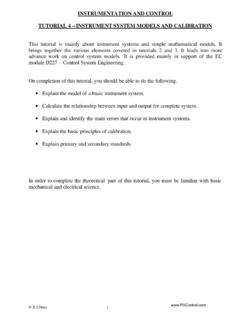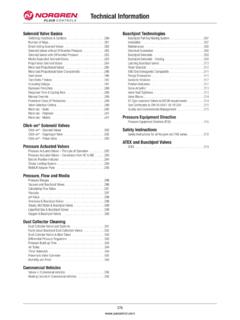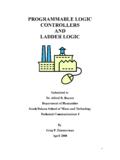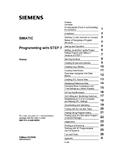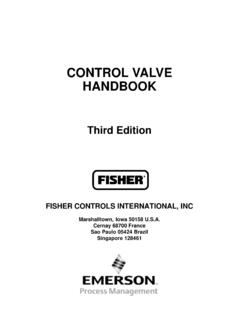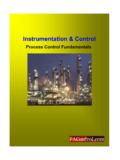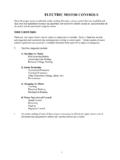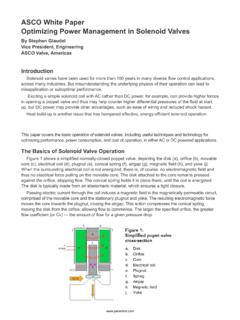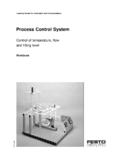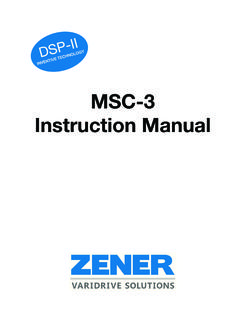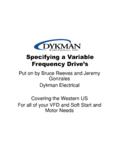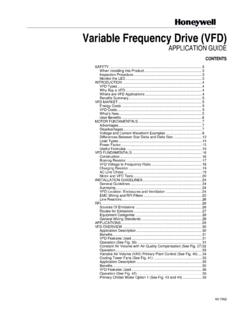Transcription of Adjustable Speed Drives - PAControl.com
1 1AC Adjustable Speed Drives (ASD s) variable Speed ControlThe simplest and least expensive way to control the Speed of a process or piece of equipment is tooperate all the equipment at full applications require the Speed of a process or piece of equipment to be to the advent of the AC Adjustable Speed Drive, many technologies have been used,although each has its inherent advantages and of variable Speed Control:Control Valves, Dampers and VanesFossil Fuel EnginesEddy Current ClutchesHydraulic CouplingsVariable Pitch SheavesDC Solid State ControllersAD Adjustable Speed Drives (ASD s)AC Adjustable Speed Drives (ASD s)AC Adjustable Speed Drives (ASD s) have become verypopular variable Speed control devices used in industrial,commercial and some residential applications. CThese devices have been available for about 20years and have a wide range of applicationsranging from single motor driven pumps, fans andcompressors, to highly sophisticated operate by varying the frequency of the AC voltage supplied to the motor using solidstate electronic systems are fairly expensive but provide a higher degree of control over the operationand in many cases, reduce the energy use enough to a least offset if not more than pay for theincreased s allow precise Speed control of a standard induction motor and can result in significantenergy savings and improved process control in many control the Speed of a standard squirrel cage NEMA type B induction not only for new applications, but also for retrofit on existing Speed '120 X FrequencyNumber of PolesAdjustable Speed Drive (ASD)
2 FunctionAC Adjustable Speed Drives can bethought of as electrical control devicesthat change the operating Speed of s are able to vary the operatingspeed of the motor by changing theelectrical frequency input to the Speed an AC induction motor operates is given by the following equation:Where:Frequency = Electrical frequency of the power supply in of poles = Number of electrical poles in the motor Speed can be changed by altering the electrical frequency, the # of poles, or Speed can be changed by altering the # of poles in a motor from 4 to 2:4 pole motor operating on 60 hertz = 1800 pole motor operating on 60 hertz = 3600 really CHANGED Speed rather than varied Speed !CMotor Speed can be changed by altering the frequency of the electrical supply:4 pole motor operating on 50 hertz = 1500 pole motor operating on 40 hertz = 1200 varying frequency, we can adjust the Speed over a wide range or vary the Speed preciselyusing precise changes in the electrical frequency input to the ' Speed (in RPM) x Torque (in pound&feet)5,252 Power and TorqueASD's actually control both frequency and voltage simultaneously to maintain a constant volts/hertzratio which keeps current flow similar to full Speed allows the motor to draw full current at any Speed and produce full torque as motorspeed happens to the Horsepower when we lower the Speed and torque using frequency?
3 CReduced Horsepower = Reduced Energy Use = Energy Savings!!!!!!!!!!!What About INCREASING Speed ?Some specially designed motors meant for use with ASD s are designed to operate at higher thannormal speeds at frequencies above 60 frequency above 60 hertz makes the motor run faster than normal and creates twoprimary concerns:1. Was the motor or the load it Drives designed to operate at these increased speeds? SMany motors and devices were not mechanically balanced to operate at increasedspeeds and will create vibration, mechanical and safety ASD's are not capable of increasing voltage so as frequency increases above 60 hertz, thetorque produced starts to order to maintain a constant horsepower output to drive our load, if Speed isincreased, torque must decrease!At some point of increased Speed we may not be able to produce enough torque to drive the load andat this point, the motor will slow even with increasing point is different for each manufacturer's motor and dependant on the torque required bythe load.
4 Only the manufacturer can help determine when this Advantages & DisadvantagesAdjustable Speed Drives have a number of advantages and disadvantages compared to other types ofvariable Speed controls including:AdvantagesDisadvantagesCEnergy CostCImproved Process Heating at low SpeedsCReduced Voltage System HarmonicsCBypass Power Line HarmonicsCMulti-motor ControlAdvantages - Energy SavingsAdjustable Speed Drives can be used to save significant amounts of energy in process operationscompared to traditional control methods where the load or Speed of the operation Adjustable Speed Drives are among the most efficient types of Speed control when usedon axial ( variable torque) loads like centrifugal fans, pumps and the motor reduces the operating Speed of the fan, pump or compressor thehorsepower required to operate the system is greatly is a major advantage of the ASD and one of the primary reasons ASD s havebecome so popular in many process Torque LoadsVariable torque loads require much lowertorque at low speeds than at high torque required varies as the squareof the Speed and the horsepowerrequired varies as the cube of the the Speed of a variable torqueload is reduced to 50%, the torquerequired to drive the load is reduced to25% and the horsepower is reduced of the amount required to drivethe load at full load torque loads include most centrifugal and axial pumps, fans and blowers and manymixers and Torque LoadsConstant torque loads require the sameamount of torque at low speeds as at remains constant throughoutthe Speed range.
5 And the horsepowerincreases and decreases in directproportion to the change in the Speed drops to 50 percent, thenthe power required to drive theoperation will drop to 50 percent whilethe torque remains torque loads include most conveyors, positive displacement and reciprocating pumps, - Reduced Voltage StartingAn ASD acts like a reduced voltage starter to limit the amount of in-rush current when the ASD can generally limit the in-rush current to a maximum of 150%.Advantages - Improved Process ControlThe ASD is a solid state electronic device whichlends itself well to automated process can take process control signal inputs forstart/stop and Speed control and outputsignals to DCS and PLC systems, orprovide information other types of variable Speed control canbe very limited as to their interfacing to a process control system or have no - Lower System MaintenanceAn ASD can reduce system maintenance requirements forboth the control and drive train equipment compared toother types of variable Speed ASD can reduce the wear on belts, sheaves,gearboxes, and couplings in a valves can sometimes be a maintenanceproblem due to lining wear when throttling amaterial which is very caustic or extremely rough of these are wear items and can add to the overall maintenance of the process ASD does not cycle motors on and off, as commonly seen with certain processes.
6 Byeliminating the cycling of these motors, the variable frequency drive eliminates the amountof in-rush and the torque pulsations felt throughout the - Bypass CapabilityMany ASD systems make use of a bypass starterin parallel with the drive which allows the driveto be easily bypassed when critical applicationsrequire a back-up control types of variable Speed control areusually physically coupled between themotor and the load and must beuncoupled, repaired, and then re-coupledinto the line-up when there is a ASD can be bypassed in a matter of seconds where other types of Speed control may bedown for hours or even weeks, while it is being repaired if there is not a spare - Multi-Motor ControlSome ASD's can control multiple motors from thesame drive which can be an advantage over othertypes of variable Speed control advantage of this is the smallerphysical size of the control being used, aswell as the reduced initial cost of the DisadvantagesASD's are not the best choice for all variable Speed applications.
7 Some of the drawbacks to using anASD (which are generally the advantages to using other types of Speed controls) are as follows:Disadvantage - Initial CostThe initial cost of an ASD is generally greater than other types of variable Speed controls mentionedand is a common obstacle for a process plant to install the from energy savings has traditionally been used to justify installation of ASD showever improvements in process control are increasingly being energy savings payback is generally low for applications where the average speedrequirement is near the motors rated Speed a general rule, a payback of 2 to 3 years typically justifies the use of an - MaintenanceASD's, like many other solid state electronic devices,require special troubleshooting knowledge for operationsand maintenance personnel can obviously look atmechanical type devices to see if the deviceshave failed or easily diagnose the cause of 's have made significant advances in theirdiagnostic capability.
8 But still may requireadditional training for maintenance personnel notfamiliar with solid state design - Motor Heating at Low Speed OperationASD s used to run constant torque loads at slow speeds,have a high potential for motor matter what Speed the motor runs, the currentdraw to the motor will be the same with aconstant torque low speeds, the cooling fan on the motorproduces less cooling the motor produces the same amount of heat atlow Speed due to the constant torque load andthere is less cooling air, the motor will a rule of thumb, you can generally take a fully loaded Class B insulation motor down to 50percent Speed on constant torque loads without can generally take a fully loaded Class F insulation motor down to approximately 20percent Speed without overheating the a Class F insulation motor needs to be run below 20 percent Speed on a constant torqueapplication, the motor needs to be - Output Harmonic DistortionThe output electrical waveform generated by the ASD is not a pure sinewave and includes harmonicdistortion which is supplied to the harmonics are multiples of a fundamental frequency with a current component and thecurrent component will create heat in the a rule of thumb, ASD's will create between 5 to 8 percent extra heating in a motor ascompared to that same motor running on a sinusoidal waveform from the power way to overcome this problem is to use a motor with at least Class F insulation or aninverter rated motor with Class M - Induced Power Line Waveform DistortionThe ASD is a solid state electronic load and will cause waveform distortion to be induced on theinput electrical power waveform distortion created byASD s consists of both harmonicdistortion and line distortion and linenotching are a result of the non-sinusoidal waveform the drivegenerates.
9 Which pulls the current offof the power line in can severely distort theelectrical power supply within thefacility and if not properly protected,can hinder the operation of other using ASD s in the vacinity of sensitive electronic equipment should considerincluding either an isolation transformer, or line reactors on the input of the drive to protectthe other equipment from this potential of AC ASD'sThere are three different types of ASD's on the market that primarilydiffer in the type of rectification they use to convert AC to DC andback to - variable Voltage InputCCSI - Current Source InputCPWM - Pulse Width ModulatedThese Drives take the AC input voltage and frequency, covert it toDC using rectifiers, then convert it back to AC in an invertor whichchanges the voltage and Voltage Input (VVI)The VVI is the oldest AC drive technology and was the first ACdrive to gain acceptance in the industrial VVI is sometimes called a six-step drive due to the shape of the voltage waveform itsends to the Drives are fairly economical between 25 and 150 horsepower for ranges of speedreduction from 15 to 100% (about 10 to 60 Hertz).
10 CThese Drives are also used widely on specialty high Speed applications (400 to 3000 Hertz).Advantages:good Speed rangemultiple motor control from one unitsimple control regulatorDisadvantages:Power Factor decreases withdecreasing speedPoor ride through ability for low inputvoltageGenerates significant outputharmonicsLow Speed Motor Cogging (shaft pulsing/jerky motion)Requires Isolation Transformer on Input SideDuring low Speed operation (below 15-20 Hz) cogging can be a problem where the jerky motion ofthe motor shaft can create problems for bearings, gears, or gear Source Input (CSI)The CSI is very similar to the VVI except that it is more sensitive to current as opposed to a VVIdrive which is more sensitive to Drives are usually lower cost above 50 horsepower than VVI Drives for pumps and efficiency of a CSI drive may not be as high as a VVI drive and may not provide a totalenergy saving package compared to other to the current characteristics produced by the CSI, cogging can be a problem at lowspeeds similar to the voltage output is somewhat closer to the regular sine wave expected by the motor exceptfor the sharp spikes.
